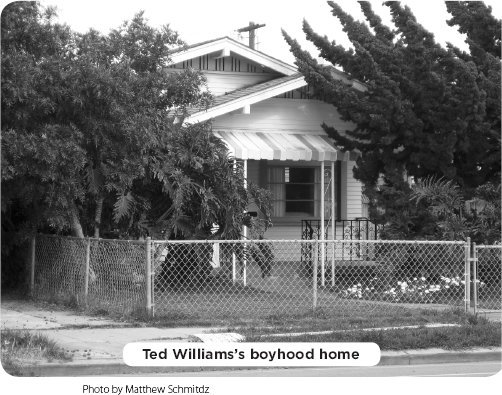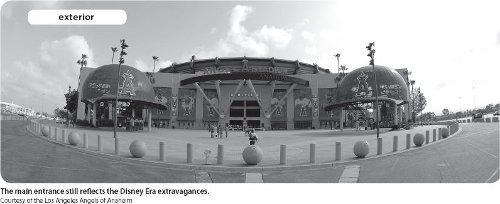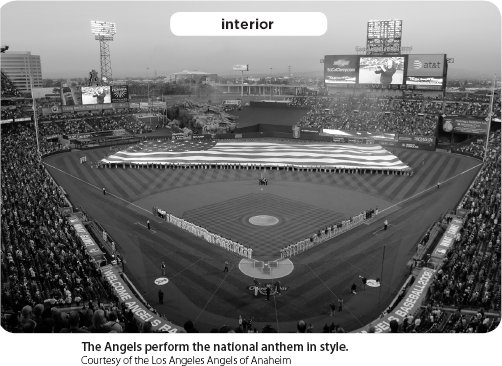Ultimate Baseball Road Trip (116 page)
Read Ultimate Baseball Road Trip Online
Authors: Josh Pahigian,Kevin O’Connell

“You okay, man? Can I have the waitress get you another orange juice?”
Then Josh looked Kevin dead in the eye and said, “Teddy Ballgame.” And it was then that Kevin understood. The beaches, the amusement rides,
the wildlife parks, none of it meant anything to Josh compared to visiting the boyhood home of one of his idols, Ted Williams.
“Okay,” said Kevin. “That sounds great.”
It was then that Josh began to perk up. In fact, he became positively giddy with excitement. “Do you think we’ll get to see his room?” he said. “I hope they have a gift shop.”
Thanks to the marvels of modern technology, we quickly looked up the address.
“We take the Ted Williams Expressway, right?” Josh asked as we headed back to the road trip mobile.
“Actually, it says we should take the Cabrillo Parkway through Balboa Park,” Kevin replied.
A confused look came over Josh’s face, but he resigned himself to trusting the Internet. We made the short drive past the zoo and into the North Park neighborhood, and the road trip mobile turned onto Utah Street.
“What a name for a street for a boy to grow up on,” Josh said looking out the window. “Utah Street. It’s almost mythical.” Kevin nodded and kept driving.
“I don’t see any signs,” Josh said. “Are we getting close? How could there not be any signs?”
“According to the GPS, we’re here,” Kevin said, slowing down the car. “It’s gotta be one of these right along here.” It was then that Josh saw the address—4121—on a modest bungalow-style house.
“Where’s the museum? Where’s the gift shop?” Josh shouted. His world was crashing down around him.
“I think it’s a private residence,” said Kevin as gently as he could.
“But how could they not turn this house—the house that the greatest hitter who ever lived grew up in—into a museum,” Josh cried. “It doesn’t make … It’s not right … It’s … It’s… It’s a crime!”
Josh bolted from the still moving road trip mobile and stumbled across the grass toward the house. And before Kevin could park the car and get out to stop him, Josh had knocked on the door. By the grace of God, there was no one home—or at least no one who answered the door. When Kevin reached the doorstep, Josh’s head was hanging low again.
“You wanted to see his room, didn’t you?” Kevin said, putting a hand on Josh’s shoulder.

“Yes. And I wanted to buy something at the gift shop for my son, Spencer,” said Josh.
“Think of how much better it will be when you take him to a game at Fenway, and you can tell him the stories your dad told you about watching him play.”
“It’s okay. I’m over it. Let’s go to Sea World,” Josh said. “I heard they have a whale that can do long division. Maybe he can figure out batting averages too. I’m gonna start him off with 456 divided by 185.”
“Umm, do I want to know why?” Kevin asked skeptically.
“Because those were Teddy Ballgame’s at-bat and hit totals in 1941 when he hit .406,” Josh answered. “I figure if he’s a dividing whale from San Diego, he ought to be able to get that one in a blink of the eye.”
“Okay,” Kevin said, becoming a bit concerned for his friend once again. “I just hope you’re not setting yourself up for disappointment with unrealistically high expectations.”
“Don’t worry, I’m not,” Josh said. “It’s just like Ted said in
The Science of Hitting
: If you’re content to hit .300, that’s the best you’ll ever do. If you’re never content, you’ll keep surprising yourself.”
And so we headed to Sea World in search of the calculating whale.
 LOS ANGELES ANGELS OF ANAHEIM,
LOS ANGELES ANGELS OF ANAHEIM,ANGEL STADIUM OF ANAHEIM
Baseball in the O.C.
A
NAHEIM
, C
ALIFORNIA
31 MILES TO LOS ANGELES
95 MILES TO SAN DIEGO
335 MILES TO PHOENIX
365 MILES TO OAKLAND
U
pon our first-ever venture to Angel Stadium of Anaheim we were unsure of exactly what to expect and, frankly, any expectations we did have were not high. We knew the facility had undergone extensive renovations in the late 1990s and that then-owner Disney had played a leading role in those efforts. And that wasn’t the only thing that gave us cause for concern. We also knew that the “Big A” had served as the home of the NFL’s LA Rams from 1980 to 1994, which left us with the impression the facility was one of the few remaining cookie-cutter stadiums, despite any sprucing up Disney might have done. What’s more, we rolled into La La Land believing the old rap about Angel fans that portrays them and their nearby National League brethren as tardy arrivers and early departers more concerned with making an appearance at the ballgame than actually cheering on the home team to victory.
In the end, just about every negative expectation we had proved unfounded. Indeed, many of the fans were an inning or two late in arriving. But beyond that, everything else we expected to find disagreeable about the “Big A” failed to materialize. Angel Stadium is indeed a stadium, not a ballpark. There’s no denying that. But it is one of the better ones. Of course, it doesn’t measure up to Yankee Stadium, but it sure beats the heck out of the Oakland Coliseum. Not only are the views superb from all three seating decks, but the earth-tone decor and ballpark accents promote an old-time flair. As for the fans, once they got settled into their seats they were loud and involved in the game. Yes, they are a little bit too sunnily disposed toward that silly Rally Monkey, but most of them know their baseball and stay until the final out. And the game-day presentation the Angels and their ballpark staffers make is so much fan-friendlier than at Dodger Stadium. We can see why Angels’ attendance has been increasing every year while the Dodgers have been steadily slipping from the once lofty perch they inhabited near the top of the game’s attendance ledger.
With the San Bernardino Mountains rising in the distance beyond the left-field fence, Angel Stadium provides some sweet views when the smog isn’t too thick, as well. Inside, the Angels embrace the mountain theme with an outfield rock-and-water display in left-center that—while less impressive than the similar feature at Coors Field in Denver—provides a trademark accent that meshes nicely with the distant mountain view.
Josh:
The rocks look fake to me.
Kevin:
Use your imagination.
Josh:
I’m trying. But all I can picture is a fake mountain.
Kevin:
I forgot. You’re from back East. Never mind.
Other than the outfield scenery and a gaudy but strangely pleasant main entrance, Angel Stadium is not too overdone. We like that. Baseball is the main attraction, the way it should be and the way it was back in 2002 when the Angels went 8-1 at home in the three playoff rounds en route to their first World Series. Ever since, the Angels have been perennial contenders for the AL West title and the team has continued to gain followers.
By claiming that 2002 Championship, the Angels officially stamped Anaheim on the MLB map as a bona fide big league town. Previously, the team had played second fiddle in the hearts and minds of many fans who’d grown up vowing allegiance to the Dodgers. But that was before the fourth-ever all-California World Series pitted the Angels against the Giants. Today’s Angels not only have a World Series trophy to go with their resilient stadium, but a strong following. They also have a committed owner who isn’t afraid to spend his money on premium talent. Arte Moreno acquired the club from Disney back in 2003 for $185 million and launched an aggressive rebranding campaign that has increased the team’s presence in the LA market and brought new revenue streams flowing into the coffers.
Getting back to that 2002 season and just how significant a moment it was for this franchise: Consider that in 2001
the Angels had finished forty-one games behind the first-place Mariners in the AL West. That’s right, forty-one back! And the Angels hadn’t been a factor in the division since blowing a thirteen and a half game lead in 1995 and then losing a one-game playoff to the Mariners for the division title. In the years between the Angels’ 1986 implosion against the Red Sox, in their only previous American League Championship Series, and 2002, the team went through six managers, four general managers, three logo changes, a ballpark makeover, and a geographic identity crisis that saw them change their name from the California Angels to the Anaheim Angels. Never mind the World Series, the Angels’ 2002 AL Championship represented the team’s first league title in its 42-year history. The Angels came on strong in the second half of that season to finish with a 99-63 record—the best in team history. But they still finished four games behind Billy Beane’s money-balling Oakland A’s in the AL West. Fortunately, they earned the AL Wild Card berth. And after running through the Yankees and Twins, they overcame a three-games-to-two deficit in the October Classic and 5–0 deficit in Game 6, to win the whole ball of wax. In the decade to follow they finished among the top six teams in baseball in average nightly attendance every single year. Usually the Yankees, Dodgers, Phillies, and Cardinals finish ahead of the Angels and they vie with a handful of other clubs for the fifth best attendance mark. They consistently average more than forty thousand fans per game and more than 3.2 million per season.

Kevin:
And you said West Coast teams weren’t serious about their baseball.
Josh:
When did I say
that
?
Kevin:
Trust me, if I’ve said it, which I have, you’ve said it.
Angel Stadium was originally known as Anaheim Stadium. It opened for baseball in 1966 and was expanded in 1979 to accommodate the Rams. It was remodeled again between 1997 and 1999 to undo much of what the 1979 renovation had wrought. Ballpark architectural firm HOK Sport played a leading role as the Big A was retro-fitted from cookie-cutter back to baseball stadium in the wake of the Rams’ departure for greener—though more artificial—pastures in St. Louis. With some help from Disney, which footed most of the $118-million price tag, HOK eliminated nearly twenty thousand outfield seats, added a video board and out-of-town scoreboard, and created the fake mountainside in left. During this time, the ballpark shed the name Anaheim Stadium and became “Edison International Field of Anaheim” after a hefty payout from the local energy company. In 2003, Moreno opted to return to a geographic and team focus and renamed the facility “Angel Stadium of Anaheim.” Though Moreno would have liked to have changed the name of the team itself to the Los Angeles Angels, contractual obligations with the city of Anaheim mandated that the city name be in the team title, so the team was given the rather clunky and redundant moniker “The Los Angeles Angels of Anaheim.”
Prior to opening “Anaheim Stadium” in 1966, the Angels had spent their first five seasons as vagabonds, crashing wherever they could find an open field. Well, maybe that’s a slight exaggeration. But it’s true that the team founded
by movie star Gene Autry and former football player Bob Reynolds in 1960 played its inaugural 1961 season at Los Angeles’s Wrigley Field, an expanded minor league park that once belonged to the Cubs. How cozy was little Wrigley? The seating capacity was 20,500. And the Angels and their opponents combined to hit a record 248 home runs in eighty-one games at the park that season. The next year, the Angels moved to Dodger Stadium, where they played until Anaheim Stadium was constructed. With the move to Anaheim, the team changed its name to the California Angels.

After the 1979 remodeling to accommodate the Rams, folks took to calling the facility the Bigger A as the once-open skyline across the outfield was shuttered by all of the new seats. Now that these seats have been removed, Angel Stadium resembles the original Anaheim Stadium once more.
From the start, Angel ownership attempted to fuse baseball with the area’s reputation as an entertainment hub, as the team passed from the estate of the “Singing Cowboy” to the Walt Disney Company in 1996. Shortly thereafter the team changed its name to the Anaheim Angels. After the team won the 2002 World Series, both the old and new ownership groups took part in the celebration. Gene Autry’s widow, Jackie, stood beside Disney boss Michael Eisner on the field, and together they accepted the World Series trophy, along with Troy Glaus, the Series MVP. While Jackie Autry reached for the championship trophy with one hand, she held up her late husband’s cowboy hat with the other. It was a touching moment.
Autry was more like legendary Red Sox owner Tom Yawkey than he was like George Steinbrenner. He was an aged father figure who loved his team and its players, maybe too much for his own good. As for Disney’s short reign? Well, not only did Eisner and Co. fix up the set but they significantly hiked the studio … er … ticket prices. They even had the gall to charge admission to the Victory Parade in October 2002. Perhaps because Anaheim didn’t have any buildings tall enough to have a true ticker-tape procession, or because Disney was out to make a buck, the celebration was held at Disneyland. In any case, Disney sold the Angels in the middle of the next season, bringing an end to its short tenure as team steward.
As for historic moments, this ballpark has seen a few. In 1967 it was the setting of the first All-Star Game played during prime-time evening hours on TV. The NL prevailed 2-1 in fifteen innings. Tony Perez homered off Catfish Hunter—working his fifth inning in relief—in the top of the fifteenth for the deciding margin.
Josh:
How the game has changed!
Kevin:
Hard to imagine a “short man” going that long today.
On September 23, 1973, Nolan Ryan struck out sixteen Twins in his final start of the season to break Sandy Koufax’s single-season strikeout record. The Ryan Express racked up 383 punch-outs to best Koufax by a single K. Afterward it was revealed that Ryan had pitched the eleven-inning game with a torn thigh muscle.
In his final start of the next season, Ryan pitched his third career no-hitter and his first in Anaheim—again baffling the Twins—on September 28, 1974. But the Big Texan was just getting started. The next season Ryan authored his record-tying fourth no-no, beating the Orioles 1-0 in Anaheim. He would pitch three more no-hitters before retiring after the 1993 season with 324 wins, 5,714 strikeouts, and a 3.19 career ERA. The Angels retired Ryan’s number 30 in 1992. In 291 games for the Angels, he posted a 138–121 record to go with a 3.06 ERA. The 138 Angel Ws were the most Ryan earned with any one team during a career that also saw him pitch for the Mets (29 wins), Astros (106), and Rangers (51).
Josh:
Funny, but he’s more commonly remembered as an Astro or Ranger.